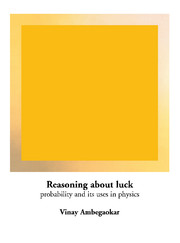Book contents
- Frontmatter
- Contents
- Preface
- 1 Introduction
- 2 The likely, the unlikely, and the incomprehensible
- 3 Normality and large numbers
- 4 Examples
- 5 A little mathematics
- 6 Forces, motion, and energy
- 7 Atoms, molecules, and molecular motion
- 8 Disorder, entropy, energy, and temperature
- 9 Heat, work, and putting heat to work
- 10 Fluctuations and the arrow of time
- 11 Chaos
- 12 Quantum jumps: the ultimate gamble
- Index
10 - Fluctuations and the arrow of time
- Frontmatter
- Contents
- Preface
- 1 Introduction
- 2 The likely, the unlikely, and the incomprehensible
- 3 Normality and large numbers
- 4 Examples
- 5 A little mathematics
- 6 Forces, motion, and energy
- 7 Atoms, molecules, and molecular motion
- 8 Disorder, entropy, energy, and temperature
- 9 Heat, work, and putting heat to work
- 10 Fluctuations and the arrow of time
- 11 Chaos
- 12 Quantum jumps: the ultimate gamble
- Index
Summary
Time doth transfix the flourish set on youth,
And delves the parallels in beauty's brow,
Feeds on the rarities of Nature's truth,
And nothing sows but for his scythe to mow.
ShakespeareIsolated systems left to themselves, we have argued, evolve in such a way as to increase their entropy. The successes achieved by the use of this principle in the last two chapters cannot, however, hide the fact that it has up to now been pure assertion, more than reasonable to be sure but only vaguely connected to the motions of the microscopic constituents of matter. Let us now explore this connection, and the reasons why time and disorder flow in the same direction.
This is a curiously subtle question. From the point of view of common sense, it is not a puzzle at all. Shown a film of, for example, a lit match progressively returning to its unburnt condition, we instantly recognize a trick achieved by running a projector backwards. While it is by no means true that every macroscopically quiescent material object is in equilibrium, it is a general feature of common experience that left to themselves inanimate isolated systems become increasingly disordered. Even when the process is very slow, it is inexorable: cars eventually rust away. More often, it happens in front of your eyes: the ice cube in your drink melts, the sugar you add to your tea dissolves and never reassembles in your spoon.
- Type
- Chapter
- Information
- Reasoning about LuckProbability and its Uses in Physics, pp. 168 - 183Publisher: Cambridge University PressPrint publication year: 1996

